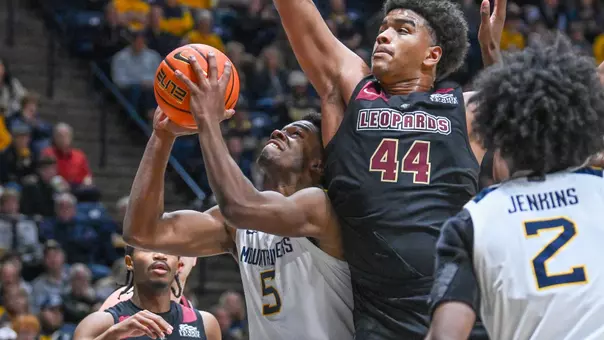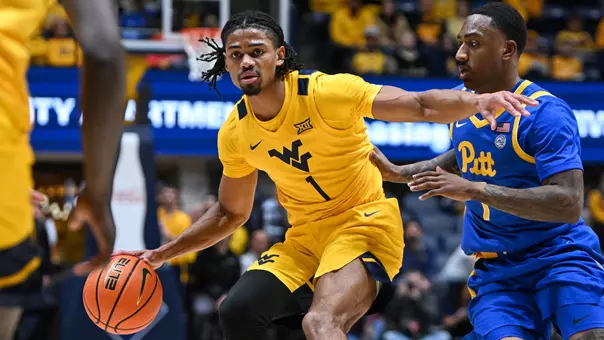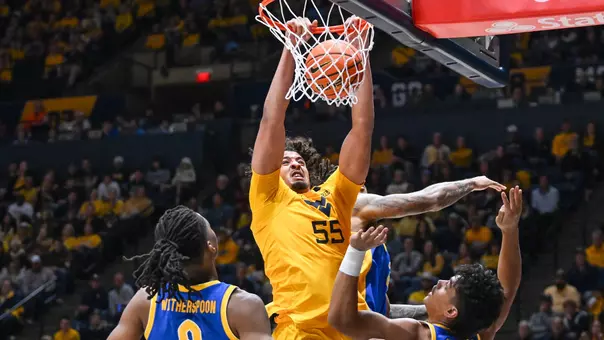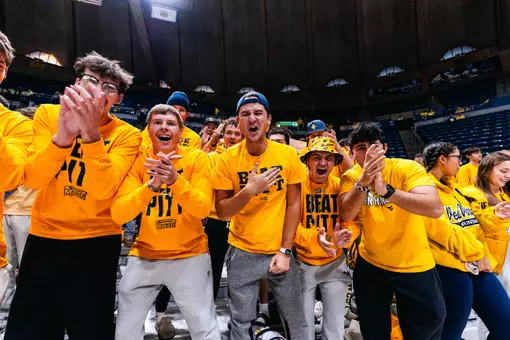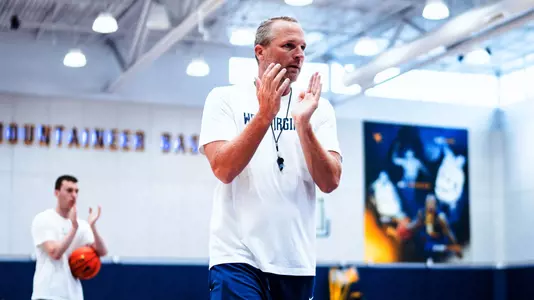
DeVries Provides Insight on Roster Construction and Style of Play
June 27, 2024 12:42 PM | Men's Basketball, Blog
MORGANTOWN, W.Va. – We are getting to know new West Virginia University men's basketball coach Darian DeVries a little bit better through the handful of public interactions he's had since his late-March hiring.
DeVries was a guest on Jeff Goodman's After Dark Field of 68 Podcast in late May, and earlier this week, he joined Jon Rothstein's College Hoops Today Podcast.
Then late yesterday afternoon, Tony Caridi and Hoppy Kercheval pinned DeVries down for an hour-long interview on their popular 3 Guys Before the Game Podcast that was missing No. 3 guy Brad Howe for this particular episode.
After listening to all three podcasts, it's obvious DeVries has a clear understanding of what he wants to do and how he wants to do it.
Goodman and Rothstein asked him to single out individual players, and in both instances, DeVries demurred, pointing instead toward the whole instead of the sum of the parts.
"I really like the way it has come together," he told Rothstein on Monday's podcast. "It took us a while to get going as we were putting the staff together and getting our roster started through the portal and things; I think we've got great chemistry.
"I think the pieces all fit well together, so I think we will have an opportunity to have a very competitive team, and a team that I know is hungry with a lot of guys that are looking forward to the challenges that they are going to see every night."
Rothstein did ask DeVries about the adjustments his son, Tucker, a two-time Missouri Valley Player of the Year, considered among the best players in this year's transfer portal, needs to make playing in the Big 12 Conference this year.
"Overall, the length (he is going to face)," he noted. "I think that increases dramatically as you take that next step, and I think you see that across a lot of rosters. Instead of 6-4, you have 6-7 or 6-8 and all the way at every position, you just have more length and a little more athleticism."
Rothstein also inquired about Illinois transfer and former four-star prep performer Amani Hansberry, who grew up in nearby Silver Spring, Maryland.
Hansberry is a 6-foot-8, 240-pounder who appeared in 19 games last season for the Illini, which lost to national champion Connecticut in the Elite Eight.
"I really like him," DeVries said. "First of all, he's a tremendous kid. He works unbelievably hard, and we can play him at multiple positions. We'll play him a little bit at the four, but also as kind of a small-ball five, and he has the ability to stretch the floor.
"When you are going to be a little bit undersized, that's a tremendous advantage to have someone who can step out and shoot and draw out bigger defenders and make them play him."
Surprisingly, Rothstein didn't mention touted Oklahoma State transfer Javon Small, who was probably the best player on the floor when the Cowboys defeated West Virginia 70-66 in Stillwater this past January.
Small, a 6-foot-3, 195-pound guard, scored 15 points and grabbed 12 rebounds in that contest.
One other fascinating little nugget came out during yesterday's 3 Guys Before the Game Podcast when Caridi brought up DeVries' desire to play transition basketball.
For those too young to remember, transition basketball has been a big part of West Virginia's DNA going all the way back to the late 1940s with Lee Patton, who passed it on to Fred Schaus, who passed it on to George King, who passed it on to Gale Catlett.
Someplace between Carbon, Texas, Princeton, West Virginia, New York City and Morgantown, Patton learned the transition game and would frequently yell to Mountaineer players in his high-pitched, twangy drawl, "Run, run, run!"
Schaus perfected it in the late 1950s with All-Americans Hot Rod Hundley and Jerry West, and King continued it into the 1960s with All-American guard Rod Thorn. They used to say King was willing to fastbreak out of side-court inbounds plays just to get better offensive numbers.
This style should have continued here throughout the 1960s with guard Fritz Williams, but Duke's Bucky Waters chose to play the game differently.
Then, a decade later in the early 1980s, Catlett brought transition basketball back to WVU.
Catlett learned to play this way when he played for Schaus and King. As a coach, his training came from Lefty Driesell, Ted Owens, Adolph Rupp and even Dean Smith when Smith used to stop by the Kansas basketball offices on his way to visit his mother in Topeka.
"Dean Smith was a great coach, he had great schemes, and he was a Kansas guy," Catlett recalled. "Dean Smith was the passing game, multiple defenses, and I would guess, some of the stuff I ran.
"Coach Rupp I learned from, Lefty Driesell and Ted Owens, but some of it came from Dean Smith's idea of getting out in the fastbreak and running a secondary break and your transition game."
Transition basketball makes great sense because it's much easier to score five against four, four against three or three against two than it is five on five.
Do you remember recently how much trouble those Lon Kruger Oklahoma teams used to give West Virginia with its great transition players?
Jim Crutchfield perfected this style with his a free-wheeling, up-tempo system during his days coaching Division II West Liberty in the Mountain East Conference before heading to Florida's Nova Southeastern and winning a national championship in 2023. Boston Celtics coach Joe Mazzulla even referenced Crutchfield after his team's dominating run this year that culminated with a 4-1 series win over Dallas in the NBA Finals.
Mazzulla said there were many sleepless nights when he coached at Fairmont State preparing for Crutchfield's West Liberty teams.
Cam Henderson, at Marshall, played a similar way, which he passed on to Red Brown, who coached at WVU in between Patton and Schaus.
Do you see a pattern forming here?
Good, knowledgeable basketball people in this state have embraced the transition game for a long, long time.
When Jerry West was choosing between West Virginia and Maryland, style of play was a big factor in his decision to pick the Mountaineers. At the time, the Terps played a deliberate controlled, slowed-down style.
"I just couldn't play that way," the late West said.
Getting back to DeVries, he indicated to Caridi that he first became enamored with transition basketball during his days working with Greg McDermott at Creighton.
"I was with Dana Altman for a long time, and we played pretty fast, and then Greg McDermott came from Iowa State and when he started, he was heavy (offensive) set guy," DeVries explained. "It was after his first year at Creighton, and we had his son Doug McDermott, and we made either the CIT or the CBI, whichever one it was.
"Anyway, for that tournament, we decided we were going to open it up, have fun with it and play fast and free. And it stuck. Our offense really took off. Over the next six, seven years with coach McDermott, that's where the transition game kind of got implanted in the way I wanted to see things and how I wanted to play too."
To play this way, it requires smart, instinctive players who have a great feel for the game.
"We run a lot of set plays, just like everyone else does, but we also rely on our guys making decisions, plays and reads on their own," DeVries said. "To do that, you've got to have a good understanding of how the game is played and what gives us the best advantage at both ends of the floor.
"I tell our guys all the time, 'If our play is designed to go left or right and your guy falls down, I don't need you to go left or right anymore. Just go straight.' That's how I want them to play. Just because I have a play called … break off the play if that's what is required in that particular instance."
DeVries concluded, "We teach concepts and what they are looking for, but when they are out there, I want them to trust themselves and play fast."
Playing fast is something most old-time Mountaineer basketball fans can certainly relate to.
DeVries was a guest on Jeff Goodman's After Dark Field of 68 Podcast in late May, and earlier this week, he joined Jon Rothstein's College Hoops Today Podcast.
Then late yesterday afternoon, Tony Caridi and Hoppy Kercheval pinned DeVries down for an hour-long interview on their popular 3 Guys Before the Game Podcast that was missing No. 3 guy Brad Howe for this particular episode.
After listening to all three podcasts, it's obvious DeVries has a clear understanding of what he wants to do and how he wants to do it.
Goodman and Rothstein asked him to single out individual players, and in both instances, DeVries demurred, pointing instead toward the whole instead of the sum of the parts.
"I really like the way it has come together," he told Rothstein on Monday's podcast. "It took us a while to get going as we were putting the staff together and getting our roster started through the portal and things; I think we've got great chemistry.
"I think the pieces all fit well together, so I think we will have an opportunity to have a very competitive team, and a team that I know is hungry with a lot of guys that are looking forward to the challenges that they are going to see every night."
Rothstein did ask DeVries about the adjustments his son, Tucker, a two-time Missouri Valley Player of the Year, considered among the best players in this year's transfer portal, needs to make playing in the Big 12 Conference this year.
"Overall, the length (he is going to face)," he noted. "I think that increases dramatically as you take that next step, and I think you see that across a lot of rosters. Instead of 6-4, you have 6-7 or 6-8 and all the way at every position, you just have more length and a little more athleticism."
Rothstein also inquired about Illinois transfer and former four-star prep performer Amani Hansberry, who grew up in nearby Silver Spring, Maryland.
Hansberry is a 6-foot-8, 240-pounder who appeared in 19 games last season for the Illini, which lost to national champion Connecticut in the Elite Eight.
"I really like him," DeVries said. "First of all, he's a tremendous kid. He works unbelievably hard, and we can play him at multiple positions. We'll play him a little bit at the four, but also as kind of a small-ball five, and he has the ability to stretch the floor.
"When you are going to be a little bit undersized, that's a tremendous advantage to have someone who can step out and shoot and draw out bigger defenders and make them play him."
Surprisingly, Rothstein didn't mention touted Oklahoma State transfer Javon Small, who was probably the best player on the floor when the Cowboys defeated West Virginia 70-66 in Stillwater this past January.
Small, a 6-foot-3, 195-pound guard, scored 15 points and grabbed 12 rebounds in that contest.
One other fascinating little nugget came out during yesterday's 3 Guys Before the Game Podcast when Caridi brought up DeVries' desire to play transition basketball.
For those too young to remember, transition basketball has been a big part of West Virginia's DNA going all the way back to the late 1940s with Lee Patton, who passed it on to Fred Schaus, who passed it on to George King, who passed it on to Gale Catlett.
Someplace between Carbon, Texas, Princeton, West Virginia, New York City and Morgantown, Patton learned the transition game and would frequently yell to Mountaineer players in his high-pitched, twangy drawl, "Run, run, run!"
Schaus perfected it in the late 1950s with All-Americans Hot Rod Hundley and Jerry West, and King continued it into the 1960s with All-American guard Rod Thorn. They used to say King was willing to fastbreak out of side-court inbounds plays just to get better offensive numbers.
This style should have continued here throughout the 1960s with guard Fritz Williams, but Duke's Bucky Waters chose to play the game differently.
Then, a decade later in the early 1980s, Catlett brought transition basketball back to WVU.
Catlett learned to play this way when he played for Schaus and King. As a coach, his training came from Lefty Driesell, Ted Owens, Adolph Rupp and even Dean Smith when Smith used to stop by the Kansas basketball offices on his way to visit his mother in Topeka.
"Dean Smith was a great coach, he had great schemes, and he was a Kansas guy," Catlett recalled. "Dean Smith was the passing game, multiple defenses, and I would guess, some of the stuff I ran.
"Coach Rupp I learned from, Lefty Driesell and Ted Owens, but some of it came from Dean Smith's idea of getting out in the fastbreak and running a secondary break and your transition game."
Transition basketball makes great sense because it's much easier to score five against four, four against three or three against two than it is five on five.
Do you remember recently how much trouble those Lon Kruger Oklahoma teams used to give West Virginia with its great transition players?
Jim Crutchfield perfected this style with his a free-wheeling, up-tempo system during his days coaching Division II West Liberty in the Mountain East Conference before heading to Florida's Nova Southeastern and winning a national championship in 2023. Boston Celtics coach Joe Mazzulla even referenced Crutchfield after his team's dominating run this year that culminated with a 4-1 series win over Dallas in the NBA Finals.
Mazzulla said there were many sleepless nights when he coached at Fairmont State preparing for Crutchfield's West Liberty teams.
Cam Henderson, at Marshall, played a similar way, which he passed on to Red Brown, who coached at WVU in between Patton and Schaus.
Do you see a pattern forming here?
Good, knowledgeable basketball people in this state have embraced the transition game for a long, long time.
When Jerry West was choosing between West Virginia and Maryland, style of play was a big factor in his decision to pick the Mountaineers. At the time, the Terps played a deliberate controlled, slowed-down style.
"I just couldn't play that way," the late West said.
Getting back to DeVries, he indicated to Caridi that he first became enamored with transition basketball during his days working with Greg McDermott at Creighton.
"I was with Dana Altman for a long time, and we played pretty fast, and then Greg McDermott came from Iowa State and when he started, he was heavy (offensive) set guy," DeVries explained. "It was after his first year at Creighton, and we had his son Doug McDermott, and we made either the CIT or the CBI, whichever one it was.
"Anyway, for that tournament, we decided we were going to open it up, have fun with it and play fast and free. And it stuck. Our offense really took off. Over the next six, seven years with coach McDermott, that's where the transition game kind of got implanted in the way I wanted to see things and how I wanted to play too."
To play this way, it requires smart, instinctive players who have a great feel for the game.
"We run a lot of set plays, just like everyone else does, but we also rely on our guys making decisions, plays and reads on their own," DeVries said. "To do that, you've got to have a good understanding of how the game is played and what gives us the best advantage at both ends of the floor.
"I tell our guys all the time, 'If our play is designed to go left or right and your guy falls down, I don't need you to go left or right anymore. Just go straight.' That's how I want them to play. Just because I have a play called … break off the play if that's what is required in that particular instance."
DeVries concluded, "We teach concepts and what they are looking for, but when they are out there, I want them to trust themselves and play fast."
Playing fast is something most old-time Mountaineer basketball fans can certainly relate to.
The Battle at the Greenbrier
Wednesday, November 19
2005 Sugar Bowl Team Reunion
Wednesday, November 19
WRES: Mountaineer Quad Recap
Wednesday, November 19
TV Highlights: WVU 81, Lafayette 59
Tuesday, November 18
